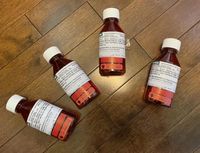Opioid withdrawal is one of the worst experiences each of has gone through more times to count. We are equally familiar with the limited choices offered that criminalize drug users when seeking relief from this horrendous experience. Aside from 12-step, abstinence-only programs—which are not only unpopular among many who use drugs but also demonstrate extremely low success rates (even by their own standards) and could be described as cult-like— this leaves little to no options. We must either risk the adulteration and instability of the illegal market, or relinquish our freedom and self-respect to the “liquid handcuff” regulations of methadone maintenance programs.
Another option is buprenorphine. Buprenorphine is less restricted but may not “hold” people who have a high tolerance for opioids. Meanwhile, safe supply programs offering hydromorphone tablets or injectables are only available to a select few in a handful communities.
The two of us have experienced these stark choices in two different places—Canada and the United States—with different norms, cultural standards, and socio-political contexts. So while our pasts have much in common, our locations have given us a different set of experiences and perspectives.
Greater cooperation between drug users and our allies across geographic and political boundaries can work to all of our advantage. Comparing the situations of different countries can ultimately help us achieve the goals of a safer and just world for people who use drugs. A specific example of how greater cooperation between jurisdictions could improve the policies regarding take-home methadone doses; India has implemented take-home doses during the pandemic. This is a simple solution, why hasn’t every country followed suit?
Better communication could improve understanding in the legitimacy of our views. Barriers and discrepancies in accessing opioid replacements exist across borders. Incorporating the views of those of us who need to access these services would eliminate some of those barriers. This is essential for those of us who use illegal opioids like fentanyl, heroin, or any other analogue of synthetic opioids. People who use “those drugs” have been subjected to endless campaigns intended to stigmatize, criminalize, and marginalize us.
“People who use “those drugs” have been subjected to endless campaigns intended to stigmatize, criminalize, and marginalize us.”
Improved communication can also allow for comparisons between strategies, policies and experiences to make programming more effective. For example, while both authors have always been baffled by the extensive rules and regulations applied to Methadone, comparing the experiences of those accessing these services can highlight the differences in programming between Canada and the U.S. For example, while the differences between how the US and Canada organize, administer, and deliver Methadone are dramatic with Canada being the more progressive of the two, many people in the U.S. are unaware of how substandard their treatment is compared to those to the North. This becomes apparent in a side-by-side comparison of the two countries’ policies.
A first step is the prescriber, in Canada prescribers had been forced through a certification process which was identified as a barrier, so currently, the program is only suggested rather than required. Compared to the clinic system in the U.S., patients in Canada are typically dispensed their medication at their local pharmacy. Canada is also a lot less strict around local take home doses and allowing patients to pick up their dose at their preferred pharmacy. Even those who must attend daily are at least offered a reasonably large time frame to pick up their dose, in most cases. This allows patients to live more freely, not being so restricted to a certain location and a narrow timeframe. Canadian doctors are even actively advocating for a safe supply of drugs!
Most patients in the U.S. however, receive no take-homes and must attend their clinic on a daily basis. Many are also required to attend group sessions, individual counselling, and other responsibilities not necessarily desired by, or helpful to, the patient. It is in fact, coercion.
Lastly, greater cooperation can help maximize opportunities for advocacy. Since both Canada and the US. have made Methadone more accessible as a response to COVID-19, this is the first time that some patients have received any take-homes. For some, this was the first time their lives did not revolve entirely around their methadone clinic’s dispensing schedule. Thus, we are able to make comparisons only between what happens in each country before and after the regulatory change, but also between how differences and similarities between Canada and the US policy responses affect outcomes.
“For some, this was the first time their lives did not revolve entirely around their methadone clinic’s dispensing schedule.”
Evidence generated by the kind of community cooperation we suggest, has thus far, shown that instead of the mass-diversion some were predicting, patients have, for the most part, taken their medications as prescribed. Just as importantly, the increased access to take homes has enabled greater stabilization, including greater opportunity to attend work and school, and reduced stigma, including self-stigma, as a result of not having to attend the clinic so often. There is research that shows when someone is sharing their drugs, prescribed or not prescribed its a practice of kindness, compassion and care, rather than harm.
What is the point of putting people on a life saving medication that is so restrictive it doesn’t give them a life to begin with? This kindness and compassion needs to be extended once COVID-19 is contained. It would be unethical to take away their take home doses if they have not done anything wrong.
As two people who work in drug policy through academia, freelance and nonprofit while being on methadone through the duration of our work, the conclusion is simple. When creating any policy change that will impact a population of people, collaborate with them. This goes back to one of the oldest principles of harm reduction and social justice, ‘Nothing About Us Without Us’. If governments or businesses created their services in collaboration with people who would access those services, there would be better buy-in from the community and fewer problems to mitigate in future.





